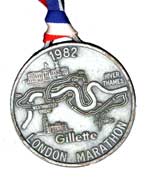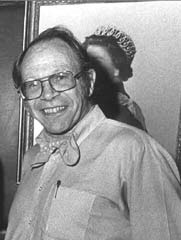
|
Ranelagh Harriers and the birth of the London MarathonNEW YORK, NEW YORK, SO GOOD THEY NAMED IT TWICE In the mid-1970s the New York City Marathon held a unique position in the running world. No other marathon on the planet had caught the public imagination to the extent that Fred Lebow’s Big Apple race had. Almost 4,000 runners finished the 1977 event on a course that wound through all five of New York’s boroughs, and if we were to believe the press reports the streets of the city were lined with tens of thousands of spectators. To British runners accustomed to running in road races accompanied by no more than a couple of hundred fellow eccentrics, with public interest largely confined to cursing motorists, the New York experience sounded almost literally out of this world. John Bryant, who is currently working on a biography of London Marathon founder Chris Brasher, takes up the story: “Like so many crazy dreams, the London Marathon was hatched in a pub. But unlike the dreams that drain away with the last pint, this one survived and grew into one of Britain’s greatest sporting events. The Dysart Arms, tucked cosily away just outside London’s Richmond Park is where Chris Brasher and John Disley, Olympic steeplechasers in a vanished age (Brasher won a gold medal in the Melbourne Olympics of 1956 and Disley a bronze medal in the 1952 Olympics) were part of a group from Ranelagh Harriers who, after training together on Wednesday nights, would swap tales and pints of bitter - recalling how fast they ran when in the full flush of youth, and dreaming of new challenges to conquer. One crazy runner, always up for a new challenge, was Steve Rowland. In the 1970s he was manager of a tiny running shoe shop in Teddington, called the Sweat Shop, where Brasher and Disley had gone into partnership selling orienteering and running shoes. Rowland had read an article about the New York Marathon and he organised a trip there in 1978 by placing a small ad in the Observer and Athletics Weekly. When these runners returned from New York they couldn’t wait to tell people about it.” For the half-dozen Ranelagh runners in the 1978 event it was an extraordinary experience and they brought home with them an infectious sense of enthusiasm and excitement about the event. In so doing, they – Steve Rowland, David Wright, Dave Daniels, Dave Williams, Norman Archer and Guy de Boursac - secured their small niche in history. BRASHER'S INSPIRATION Chris Brasher takes up the story, writing in Athletics Weekly’s London Marathon 10th Anniversary supplement: “It all started in a pub, the Dysart Arms, hard by that great running territory known as Richmond Park – the home of Ranelagh Harriers. Men drifted in from our Wednesday night run and talked, over their pints of bitter, of this marathon where the spectators never allowed you to falter – much less drop out. At the time, the early months of 1979, I was ambivalent about the marathon. The prospect of putting one foot in front of the other for 26 miles 385 yards of boring road filled me with foreboding. I could run the distance on the glorious hills of Britain but to do it on the roads, watched by three cows and a dog, was surely the height of masochism. Until I heard these stories in the Dysart Arms – stories of an incredible event known as the New York City Marathon. So I entered, ran, finished, flew home and then sat at my desk in the small hours of an October night and wrote the article first published in The Observer on 28th October 1979”. Brasher wrote in The Observer: “To believe this story you must believe that the human race can be one joyous family, working together, laughing together, achieving the impossible. I believe it because I saw it happen. Last Sunday, in one of the most violent, trouble-stricken cities of the world, 11,532 men, women and children from 40 countries of the world, assisted by one million black, white and yellow people, laughed, cheered and suffered during the greatest folk festival the world has seen. Last Sunday millions of us saw a vision of the human race, happy and united, willing their fellow human beings to a pointless but wonderful victory over mental doubt and bodily frailty. I wonder whether London could stage such a festival? We have the course, a magnificent course. But do we have the heart and hospitality to welcome the world?” THE DREAM BECOMES REALITYJohn Bryant again: “The logistics were daunting, particularly fixing the route and tearing down official red tape. New York has vast, straight avenues, easily swallowing up masses of runners. London is full of twisty, narrow streets. Yet Brasher was adamant – he wanted a race in the heart of London. Donald Trelford, then editor of The Observer, hosted a lunch in 1980 so that Brasher and Disley could meet the authorities who’d be involved in organising a marathon – among them the Greater London Council (GLC), the police, the City of London, the Amateur Athletics Association and the London Tourist Board. Within weeks, Disley came up with a course design that used the Thames as a ‘handrail’. The police, somewhat reluctantly, approved the event and the tourist board were more than happy that the event passed so many of London’s sights – the Cutty Sark, Tower Bridge, the Docks, The Embankment, Big Ben and Buckingham Palace.” A Ranelagh reconnaissance team headed by David Wright, Phil Dowling and David Dunn gave it a test run and reported “Twists and turns and dockside gloom but otherwise satisfaction”. The date was set: 29th March 1981. The event caught the public imagination to a greater extent than even Brasher could have hoped. 21,000 entry forms were received and Ranelagh volunteers were joined by a contingent from Blackheath Harriers to sort them at County Hall. Only one in three could be accepted. The Observer recruited two teams of marathon debutants, one to follow the long slow distance training plan of Ranelagh’s John Hanscomb, the other to adopt Brasher’s mixture of speed and miles. A series of articles in the newspaper charted their progress. One week before the race the director of the New York event Fred Lebow was a guest at the Dysart Arms and at the race registration at the Strand Palace Hotel it was again Ranelagh and Blackheath volunteers who were manning the desks. THE BIG DAYThe big day itself dawned cool and drizzly – fine for the runners but uncomfortable for would-be spectators. Would London’s population take the race to their hearts? Would we, after all, have the heart and hospitality to welcome the world? The answer was a resounding and uplifting “yes”. Docklands and the Isle of Dogs – still years from the development that has instilled new life in them – were all but deserted but along the popular parts of the route the crowds were six deep. Seven thousand runners set off from Greenwich, amongst them nearly thirty from Ranelagh including Brasher himself. Whilst the Norwegian Simonsen and the American Beardsley tied for victory, sixteen Ranelagh Harriers beat three hours. Remarkably, despite the pressure of organization, Brasher found sufficient energy to record 2hrs 56mins 56secs. In its first year the London Marathon had become an institution. “Nothing since Adolf Hitler and the Blitz has done more for London’s community spirit than Brasher and the London Marathon,” Chris Chataway was later to write. Ranelagh’s close involvement behind the scenes would continue for many years and several members – David Dunn, Jay Cook, Mary Smith, Steve Pratt and others – took full-time jobs with the organisation. Bill Bird and David Wright became regular drivers of the lead vehicles. Colin Gostelow was later to serve for three years as a Director of London Marathon Ltd. The number of Ranelagh competitors more than doubled in 1982, and the club provided the winner in Hugh Jones, who crossed the line on Westminster Bridge almost three minutes clear of the field in 2hrs 9mins 24secs. Thirty years on from that historic first race, Ranelagh’s Mike Peace in one of a very select group of only eighteen who have completed every London Marathon. |